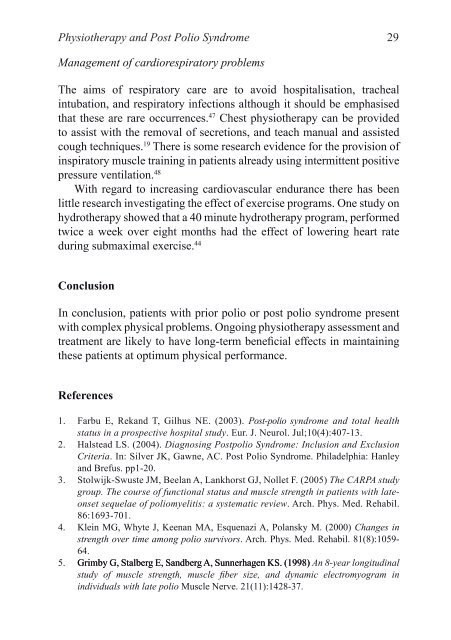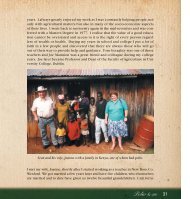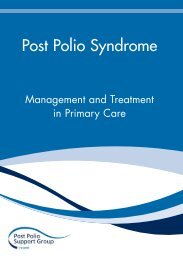Post Polio Syndrome - Management & Treatment in Primary
Post Polio Syndrome - Management & Treatment in Primary
Post Polio Syndrome - Management & Treatment in Primary
You also want an ePaper? Increase the reach of your titles
YUMPU automatically turns print PDFs into web optimized ePapers that Google loves.
Physiotherapy and <strong>Post</strong> <strong>Polio</strong> <strong>Syndrome</strong> 29<br />
<strong>Management</strong> of cardiorespiratory problems<br />
The aims of respiratory care are to avoid hospitalisation, tracheal<br />
<strong>in</strong>tubation, and respiratory <strong>in</strong>fections although it should be emphasised<br />
that these are rare occurrences. 47 Chest physiotherapy can be provided<br />
to assist with the removal of secretions, and teach manual and assisted<br />
cough techniques. 19 There is some research evidence for the provision of<br />
<strong>in</strong>spiratory muscle tra<strong>in</strong><strong>in</strong>g <strong>in</strong> patients already us<strong>in</strong>g <strong>in</strong>termittent positive<br />
pressure ventilation. 48<br />
With regard to <strong>in</strong>creas<strong>in</strong>g cardiovascular endurance there has been<br />
little research <strong>in</strong>vestigat<strong>in</strong>g the effect of exercise programs. One study on<br />
hydrotherapy showed that a 40 m<strong>in</strong>ute hydrotherapy program, performed<br />
twice a week over eight months had the effect of lower<strong>in</strong>g heart rate<br />
dur<strong>in</strong>g submaximal exercise. 44<br />
Conclusion<br />
In conclusion, patients with prior polio or post polio syndrome present<br />
with complex physical problems. Ongo<strong>in</strong>g physiotherapy assessment and<br />
treatment are likely to have long-term beneficial effects <strong>in</strong> ma<strong>in</strong>ta<strong>in</strong><strong>in</strong>g<br />
these patients at optimum physical performance.<br />
References<br />
1. Farbu E, Rekand T, Gilhus NE. (2003). <strong>Post</strong>-polio syndrome and total health<br />
status <strong>in</strong> a prospective hospital study. Eur. J. Neurol. Jul;10(4):407-13.<br />
2. Halstead LS. (2004). Diagnos<strong>in</strong>g <strong>Post</strong>polio <strong>Syndrome</strong>: Inclusion and Exclusion<br />
Criteria. In: Silver JK, Gawne, AC. <strong>Post</strong> <strong>Polio</strong> <strong>Syndrome</strong>. Philadelphia: Hanley<br />
and Brefus. pp1-20.<br />
3. Stolwijk-Swuste JM, Beelan A, Lankhorst GJ, Nollet F. (2005) The CARPA study<br />
group. The course of functional status and muscle strength <strong>in</strong> patients with lateonset<br />
sequelae of poliomyelitis: a systematic review. Arch. Phys. Med. Rehabil.<br />
86:1693-701.<br />
4. Kle<strong>in</strong> MG, Whyte J, Keenan MA, Esquenazi A, Polansky M. (2000) Changes <strong>in</strong><br />
strength over time among polio survivors. Arch. Phys. Med. Rehabil. 81(8):1059-<br />
64.<br />
5. Grimby G, Stalberg E, Sandberg A, Sunnerhagen KS. (1998) An 8-year longitud<strong>in</strong>al<br />
study of muscle strength, muscle fiber size, and dynamic electromyogram <strong>in</strong><br />
<strong>in</strong>dividuals with late polio Muscle Nerve. 21(11):1428-37.<br />
PPS Mngt and Treat.<strong>in</strong>db 29 02/07/2007 16:07:51





